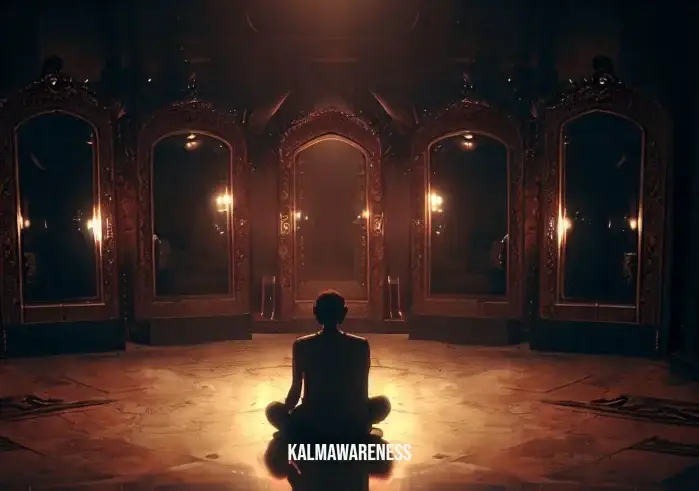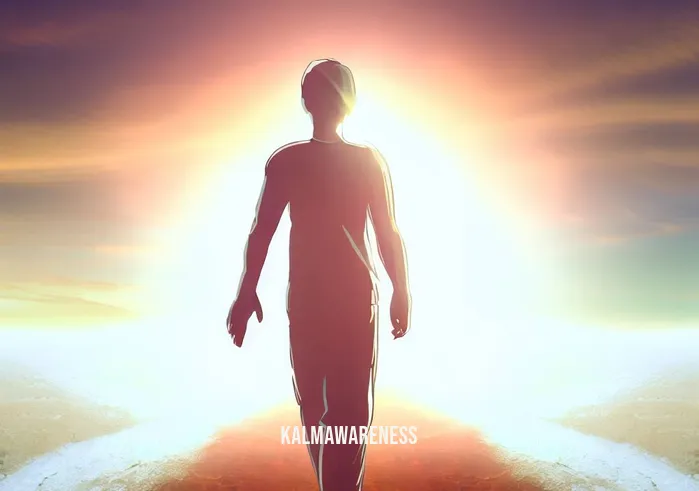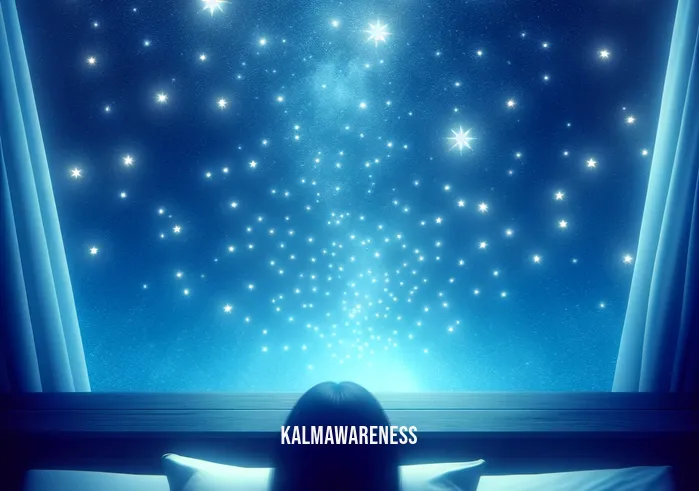The Unveiled Tranquility of Death Pose Yoga
In our constantly buzzing world, finding a moment of peace can feel like a herculean task. But, there exists a simple yet profound practice in the realm of yoga that invites us to explore a deep state of relaxation and surrender. Welcome to the exploration of Death Pose Yoga, or Savasana as it’s traditionally known.
The Unseen Power of Savasana
Savasana, colloquially known as the Death Pose, is often seen as a final relaxation pose in yoga sessions. Although it may appear as merely lying down, the essence of Savasana delves far beyond the physical. It invites us to embrace stillness, letting go, and in some sense, a symbolic ‘death’ to our restless thoughts and tensions.
In the grand scheme of things, Savasana serves as a moment of respite, a pause from our seemingly ceaseless activity. It’s an intentional act of slowing down, grounding ourselves and reconnecting with our internal state. It allows us to encounter our body and mind in a state of deep relaxation, a journey of relaxation-driven meaning.
Embracing the Stillness
Executing the Death Pose may appear simple, you lie flat on your back, palms up and eyes closed. However, the challenge arises when we strive to still our wandering minds. It’s a meditation technique of its own, a call to relinquish our hold and surrender to the quietude. Some may find help in using guided meditations like the 10-minute meditation for anxiety or the calming teddy bear breathing technique.
Remember, the practice of Savasana is a journey, not a destination. It is the pursuit of meaningfulness where we consciously make it meaningful. As we slowly peel away layers of tension, we might just discover our deepest desire for tranquility, our true ‘life direction’. But, how do we integrate this into our daily lives? And what is its greater purpose in our holistic health?
I invite you to continue exploring the world of Death Pose Yoga in the next part of this article, where we will dive deeper into the importance of this practice for our holistic health and its role in self-awareness. Stay with us as we explore the profound depths of surrender and tranquility in Savasana.

✨
Savasana: The Multifaceted Benefits of Death Pose Yoga
Having discussed the core essence of Savasana in the previous section, it’s time to delve into the myriad benefits it bestows upon practitioners. As simple as the physical posture of the Death Pose Yoga may appear, the effects ripple through the layers of our being – physical, mental, and spiritual. Let’s explore these benefits and why they’re crucial for our holistic well-being.
Physical Rejuvenation
Practicing Savasana allows the body to relax and repair. During this restful pose, our body enters a state of deep relaxation, allowing healing and restoration to occur. Savasana helps reduce fatigue, improve sleep, and balance the nervous system.
Mental Tranquility
The tranquil nature of the Death Pose Yoga helps in alleviating stress and anxiety. It invites us to enter into a state of stillness, reducing our mental clutter. The pose aids in the management of mental health issues and promotes a sense of inner peace.
Energy Alignment
Savasana serves as an essential bridge between our physical and subtle bodies. It invites us to align with our purpose, fostering harmony between our actions and intentions. It also helps to balance the energy within and enables us to take back our energy from external distractions.
Practicing Savasana
While the posture may seem simple enough – lie flat on your back, close your eyes, and relax – getting into the right mindset for Savasana can take practice. Here are a few steps to guide you:
- Set the Scene: Find a quiet, comfortable space where you won’t be disturbed. You can use a guided meditation to assist you.
- Get Comfortable: Lie down on your back with your palms facing upwards. Make sure you’re comfortable. Use props like yoga blocks or bolsters if needed.
- Focus on your Breath: Begin to notice your breath. You can use specific breathwork techniques, like whole body breathing, to deepen your relaxation.
- Relax Your Body: Start with your toes and work your way up, consciously relaxing each part of your body.
- Calm Your Mind: As thoughts arise, simply acknowledge them and let them go. Use a mantra or positive affirmation if it helps.
| Step | Action | |
|---|---|---|
| 1 | Set the Scene | Guided Meditation |
| 2 | Get Comfortable | |
| 3 | Focus on Breath | Whole Body Breathing |
| 4 | Relax Your Body | |
| 5 | Calm Your Mind |
Whether you’re a seasoned yoga practitioner or a beginner, the practice of Savasana can bring a profound sense of peace and inner stillness. It helps us connect with our deepest selves, fostering a deep-seated sense of meaning and purpose in life.
I invite you to continue to the next part of the article, where we will delve into how Death Pose Yoga influences the spiritual aspects of our being and its significance in the realm of mindfulness and meditation.

The Spiritual Facets of Savasana: Delving Deeper into Death Pose Yoga
After understanding the physical and mental benefits of Savasana, it’s time to explore the spiritual dimensions of the Death Pose Yoga. More than just a concluding posture in the yoga practice, Savasana opens a doorway into deeper states of consciousness and awareness.
A Gateway to the Inner Self
Practicing Savasana is akin to embarking on a journey within, an inner exploration. This pose encourages us to surrender completely, which in turn allows us to access our true inner self. This inner self, as suggested by Brené Brown’s core values, is our authentic self, free from pretensions and societal pressures.
A Portal to Transcendence
Savasana serves as a means to transcend beyond the physical realm. It enables us to move towards what Buddhist teacher Tara Brach calls ‘Radical Acceptance’. As we surrender in the Death Pose Yoga, we begin to embrace our reality, which leads to liberation from our self-imposed limitations. As Tara Brach said, “The boundary to what we can accept is the boundary to our freedom.” Thus, the practice of Savasana is closely tied to this idea of Radical Acceptance.
An Invitation to Let Go
The Death Pose Yoga invites us to let go. By simulating the finality of death, it encourages us to release our attachments, fears, and anxieties. This process of letting go is often associated with spiritual growth. In the words of famous yoga teacher Sara Ivanhoe, “Letting go is the hardest asana.” This idea resonates deeply with the practice of Sara Ivanhoe’s yoga.
A Mirror to Mindfulness
Savasana is also a mirror to mindfulness. It is during these moments of complete stillness and surrender that we become truly present. We begin to observe our thoughts and feelings without judgement, thus enhancing our mindfulness. As Jon Kabat-Zinn famously said, “Mindfulness is the awareness that arises through paying attention, on purpose, in the present moment, non-judgementally.” Savasana aids us in cultivating this awareness. You may explore more about mindfulness through meditation practices.
Quotes on Letting Go and Surrender
- “The day I understood everything, was the day I stopped trying to figure everything out. The day I knew peace was the day I let everything go.” – C. JoyBell C. This quote can be deeply associated with the practice of Destiny Meditation, where we surrender to the flow of life.
- “The only way to make sense out of change is to plunge into it, move with it, and join the dance.” – Alan Watts. Watts’ words beautifully align with the practice of Savasana, where we make our experience meaningful by embracing change.
- “For a seed to achieve its greatest expression, it must come completely undone. The shell cracks, its insides come out and everything changes.” – Cynthia Occelli. This transformation, as symbolised by the Death Pose Yoga, is a part of our personal growth journey.
In the next chapter, we’ll examine the symbolism of Savasana in the grand scheme of our existence and explore ways to deepen our practice. We invite you to continue this enriching journey with us.

Finding Meaning and Embracing Change with Death Pose Yoga
Continuing our journey into the depth of Savasana, let us now delve into the broader existential context of the Death Pose Yoga. Far beyond a mere physical posture, Savasana carries significant symbolic undertones that can guide us in our life’s journey and imbibe us with hope, confidence, and profound insight.
Symbolism of Savasana: From Mortality to Rebirth
At the surface level, the Death Pose Yoga, or Savasana, may seem morbid, but the essence lies not in death but in the cycle of life and transformation it symbolizes. The pose serves as a stark reminder of our transient existence, leading us to question our purpose and ignite the process of self-discovery. Herein lies the beauty of aligning with our purpose as we learn to make peace with the inescapable reality of mortality and embrace the ongoing cycle of life and rebirth.
Stages of Transformation in Savasana
| Stage | Meaning | Relevant Link |
|---|---|---|
| Surrender | Letting go of bodily tensions and mental anxieties | Relaxation-driven meaning |
| Silence | Moving from the external noise to internal stillness | Stillness meditation |
| Self-realization | Recognizing our inherent nature and essence | Deepest desire |
| Rebirth | Emergence of a new, enlightened self | A path emerges when we walk on it |
Savasana: An Exemplar of Change and Adaptation
Death Pose Yoga serves as a metaphor for change and adaptation. As we mimic the state of death, we allow old, unhelpful patterns to die, thereby making room for growth and fresh perspectives. This concept beautifully aligns with the teachings on our life direction basics page, underscoring the importance of embracing change.
The Hope and Confidence in Savasana
Far from invoking fear or apprehension, Savasana fills us with hope and confidence. It reassures us that endings are simply new beginnings in disguise. As American author Richard Bach rightly said, “What the caterpillar calls the end of the world, the master calls a butterfly.”
Similarly, Lao Tzu’s words, “New beginnings are often disguised as painful endings,” resonate deeply with the ethos of Savasana. The Death Pose Yoga teaches us to perceive every ending as a promising new start, imbuing us with hope and a deep-seated sense of meaning and purpose in life.
In the following chapter, we will delve into the practical aspects of performing Savasana, ensuring that you reap the maximum benefits from this transformative pose. We’ll also explore some common mistakes to avoid and provide tips for deepening your experience in Savasana. Stay tuned for an enlightening journey into the world of Death Pose Yoga.
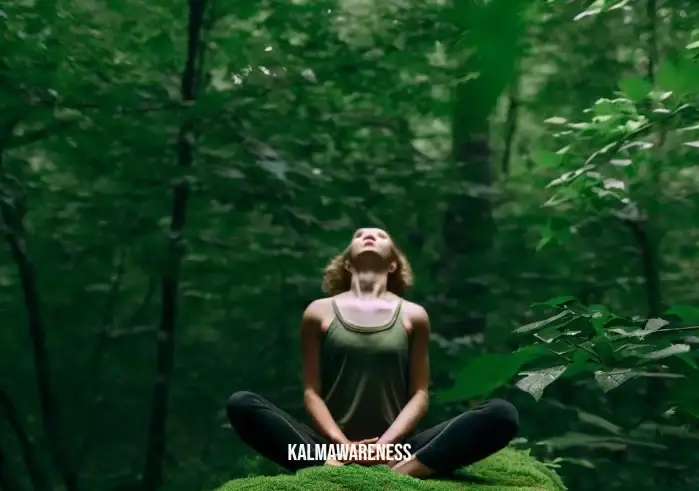
Achieving Tranquility: A Step-by-Step Guide to Death Pose Yoga
Now that we have understood the profound essence of Death Pose Yoga, it’s time to guide you through the physical steps of the pose, alongside valuable tips and practices to enhance your overall experience.
Physical Setup of Savasana
To enter the Savasana or the Death Pose Yoga, begin by laying flat on your back on a comfortable yoga mat. The use of props such as bolsters under the knees, an eye pillow or a blanket can enhance your experience. For a more comprehensive understanding of physical setups in yoga, consider exploring our right-hand poses guide.
The Importance of Breath
In Savasana, your breath is your anchor. Breathe slowly and deeply, allowing your body to relax with each exhale. Guided breathwork practices, like our vase breathing tutorial, can help enhance this process.
Mistakes to Avoid in Death Pose Yoga
Misconception: Savasana is Just Lying Down
It is a common misunderstanding that Savasana is simply lying down and relaxing. Although relaxation is a crucial aspect of this pose, it is equally important to stay mindful and aware. Refer to our post on action vs activity for a deeper understanding of mindful participation.
Mistake: Ignoring the Significance of Stillness
In Savasana, achieving physical stillness is essential. Moving or fidgeting can disrupt the relaxation process. Read more about the role of stillness in meditation on our stillness meditation YouTube page.
Enhancing Your Savasana Experience
Using Guided Meditation
You can supplement your Death Pose Yoga practice with guided meditations to deepen relaxation and focus. Visit our collection of guided meditation resources for a selection of helpful tools.
Combining Savasana with Other Practices
Savasana can be beautifully complemented with other yoga practices. For instance, the twisted root yoga pose can be a fantastic precursor to Savasana, preparing the body and mind for deep relaxation.
Using Savasana as a Tool for Introspection
Beyond physical relaxation, use the quietude of Savasana to turn inwards and contemplate deeper questions such as, “What are we doing?” and “What’s the point of this?“. It is a perfect opportunity for personal growth and introspection.
Conclusion
Incorporating Savasana into your yoga practice invites serenity, introspection, and profound personal growth. It’s a unique blend of physical relaxation and mental awakening, echoing the sentiment of French philosopher Pierre Teilhard de Chardin, “We are not human beings having a spiritual experience. We are spiritual beings having a human experience.”
In the final part of our article, we will explore the profound spiritual implications of the Death Pose Yoga, delving into its transformative power in leading us towards enlightenment and true self-realization. Embark on this enlightening journey with us, as we deepen our understanding of death, rebirth, and transcendence through the practice of Savasana.
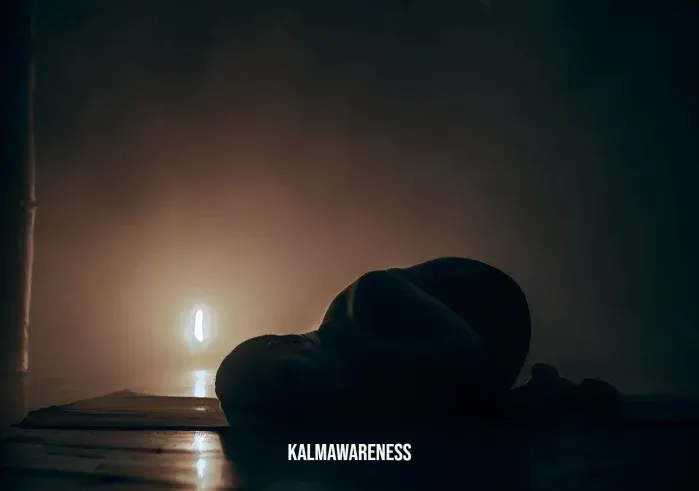
The Spiritual Resonance of Death Pose Yoga: Transcendence and Enlightenment
As we delve deeper into the profound realm of Death Pose Yoga or Savasana, it becomes evident that this practice extends far beyond physical relaxation. It encompasses a spiritual journey, leading us towards transcendence, enlightenment, and true self-realization.
Savasana as a Journey Towards Enlightenment
Yoga is not merely an exercise regimen; it’s a philosophical path leading us towards deeper understanding of our existence and purpose. Savasana, being the culminating pose of a typical yoga session, signifies the end of this journey, or rather a new beginning. The life direction basics post on our site further explores this concept.
One can perceive Savasana as a symbol of death and rebirth. It’s the end of one cycle, paving the way for the start of another. This cyclical nature is not limited to yoga; it permeates our existence, as noted in our core values – Brene Brown article.
Embodying the Divine Blueprint in Savasana
As we surrender ourselves in Savasana, we open our hearts to the universe’s divine blueprint. Here, we release our earthly struggles, allowing the universe’s energy to flow through us, guiding us on our path.
The Power of Letting Go
Death Pose Yoga teaches us the art of surrender and letting go, an essential aspect of personal growth and spiritual evolution. Letting go allows us to shed layers of past traumas, regrets, and anxieties, making room for peace, acceptance, and growth. Our post on how to take your energy back from someone provides further insights into this transformative practice.
Conclusion
“The body benefits from movement, and the mind benefits from stillness.” – Sakyong Mipham.
Death Pose Yoga serves as a bridge between the physical and spiritual, movement and stillness, life and death. It’s a doorway to deeper understanding, inner peace, and spiritual growth.
Thank you for embarking on this journey with us. We hope that this exploration of Death Pose Yoga has inspired you to delve deeper into your practice and discover the transformative power within.
Explore other articles, like meditation for dizziness and free meditation classes in NJ on our site, to continue enriching your journey of self-discovery and holistic well-being. The wisdom you seek is within you, and with tools like Savasana, you can unlock the door to your inner universe.
Remember, the path to enlightenment is not a destination but a journey. As Buddha said, “Each morning we are born again. What we do today matters most.” Embrace each day, each yoga pose, each breath with presence and intention. The path to enlightenment is yours to walk.
Thank you for reading. We wish you peace, joy, and meaningful journeys. Namaste.
